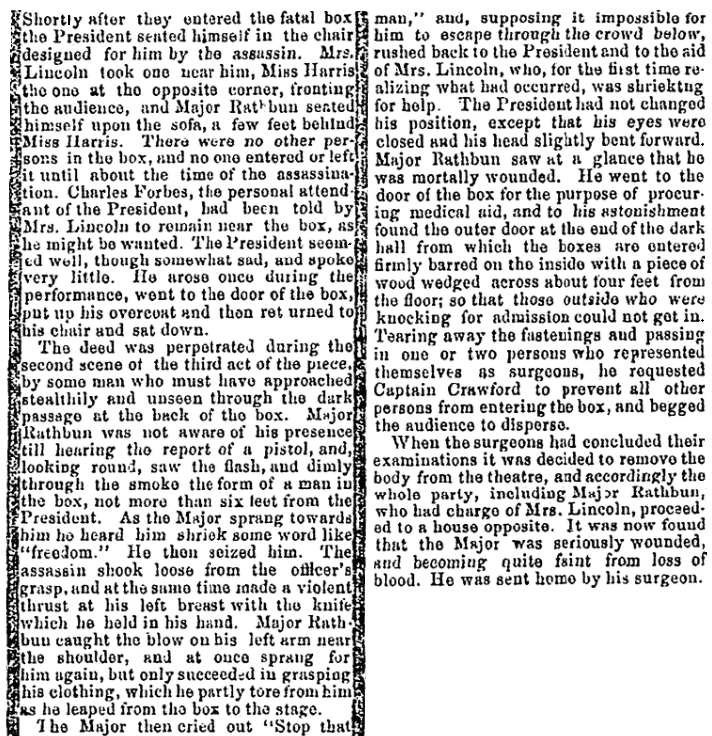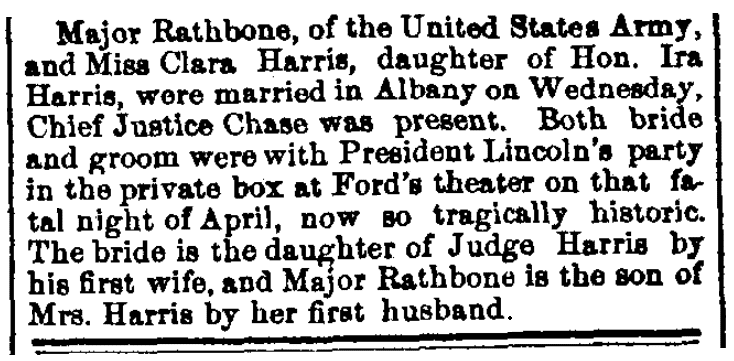Introduction: In this article, Gena Philibert-Ortega writes about some of the other victims of President Abraham Lincoln’s assassination on 14 April 1865. Gena is a genealogist and author of the book “From the Family Kitchen.”
Imagine having one incident change your life forever. One such incident, the night of 14 April 1865, affected four people, resulting in two of them being murdered and the other two being committed to an asylum. That was the night that John Wilkes Booth assassinated Abraham Lincoln – but almost 20 years later, it would also result in the murder of another person who was sitting in the Presidential Box at Ford Theatre when Lincoln was shot.
Clara Harris and Major Henry Rathbone
Most people have heard the story of the Lincoln assassination and how his killer, John Wilkes Booth, dramatically leapt from the Presidential Box to the stage yelling “Sic semper tyrannis!” (Ever thus to tyrants!) as he escaped on foot.
But have you ever wondered about who else was sitting with the Lincolns when the assassination took place? Yes, Abraham Lincoln was there with his wife Mary – but as this image shows, there was also another couple present.

That engaged couple was 31-year-old Clara Harris and 28-year-old Henry Rathbone. Clara Harris was the daughter of U.S. Senator Ira Harris of New York and Louisa Tubbs Harris. When Clara was 11 years old her mother died, and three years later her father married Pauline Penney Rathbone.
One of Pauline’s sons, Henry, later fell in love with his step-sister and became her husband (though they were step-siblings, they were not related by blood). Before marriage, Henry Rathbone worked as an attorney and then, during the Civil War, he served with the 12th Infantry Regiment. (1)
14 April 1865
Originally, General Ulysses S. Grant and his wife Julia were to accompany the Lincolns to Ford’s Theatre to watch the play Our American Cousin. But they declined the invitation and instead travelled to Burlington, New Jersey, to celebrate the end of the Civil War with their children. (2) The Lincolns then invited Major Henry Rathbone and Clara Harris to join them.
The Lincolns and their guests were enjoying the play when the assassin Booth entered the theatre box and shot the president. After hearing the shot, Rathbone jumped from his seat and tried to apprehend Booth. Booth dropped his pistol, but slashed at Rathbone with a dagger, injuring him in the left arm before he leapt from the Presidential Box to the stage.
Understandably, at first Lincoln’s head wound was thought to be the only serious injury. However, Booth had severed Rathbone’s artery and, due to the loss of blood, the major passed out. Lincoln succumbed to his injury but Rathbone’s would eventually heal.

A Cursed Night
The date of 14 April 1865 would be a turning point for many people present that night at Ford’s Theatre, including all four people in the Presidential Box. President Abraham Lincoln was killed. His widow Mary suffered from depression and grief that haunted her the rest of her life and resulted in a stay in an institution.
Henry Rathbone was never the same after that night. Although he survived his wound, he grew mentally unstable. The fact that he and Clara were in the Presidential Box the night Lincoln was assassinated was something they were forever associated with, as demonstrated in this newspaper announcement of their wedding.

The couple married in 1867 and went on to have three children. He found success in his career as a military officer and then U.S. Consul to the Province of Hanover. (3) However, his mental instability – which included drinking, multiple affairs, and gambling – also resulted in his abuse toward his wife. He accused her of being unfaithful to him and planning to leave with the children to divorce him. On 23 December 1883 Rathbone attacked his wife Clara and killed her before unsuccessfully trying to kill himself. Clara Harris Rathbone died at the hands of her husband in their home in Germany at the young age of 49 years.

He was apprehended and later declared insane. He spent his remaining years in an asylum, dying in 1911. (4)
Back in 1865, in the moments and hours after Lincoln’s assassination, Clara did everything from holding her bleeding fiancée to trying to comfort Mary Todd Lincoln. She would even spend the night at the White House and be present when Lincoln died.
Clara wrote to a friend that upon seeing her dress stained with blood, Mary Todd Lincoln said “oh! my husbands blood.” But in reality, it was the blood from Henry Rathbone’s stab wound.. (5) Clara’s dress was the subject of stories that recounted that she could not bear to get rid of it, so she hung it up in a closet and then encased it in a brick wall. It was later destroyed by her adult son Henry Riggs Rathbone because it had been a curse on the family. (6)
For both the Lincolns and the Rathbones, life after that fateful night ended with tragic death, as in the case of Abraham Lincoln and Clara Harris Rathbone, or was scarred by mental illness, as was the case of Mary Todd Lincoln and Henry Rathbone. While we tend to focus on the assassination of Lincoln, the impact of that one night had far-reaching impacts beyond the killing of a president.
Note: An online collection of newspapers, such as GenealogyBank’s Historical Newspaper Archives, is not only a great way to learn about the lives of your ancestors – the old newspaper articles also help you understand American history and the times your ancestors lived in, and the news they talked about and read in their local papers.
___________________
(1) “Henry Rathbone,” Wikipedia (https://en.wikipedia.org/wiki/Henry_Rathbone: accessed 11 April 2020).
(2) Larson, Kate Clifford. The Assassin’s Accomplice: Mary Surrat and the Plot to Kill Abraham Lincoln (New York: Basic Books, 2008), p. 89.
(3) “Henry Rathbone,” Wikipedia (https://en.wikipedia.org/wiki/Henry_Rathbone: accessed 11 April 2020).
(4) Ibid.
(5) “Attending Ford’s Theatre with the Lincolns: The Tragic Lives of Clara Harris and Henry Rathbone,” New-York Historical Society Museum & Library (http://blog.nyhistory.org/attending-fords-theater-with-the-lincolns-the-tragic-lives-of-clara-harris-and-henry-rathbone/: accessed 11 April 2020).
(6) Ibid.
Related Articles:
